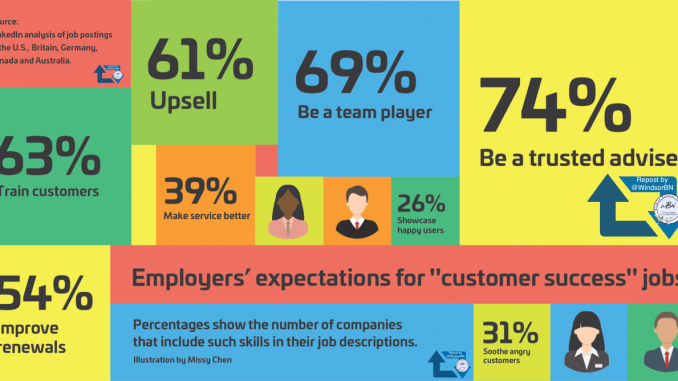
… but what do people with this job title do exactly?

If sales are soaring but users stumble, this rescue crew is ready for action
What happens when your product team is on a roll; your sales squad is beating quota — and your customers, um, aren’t quite as happy as you hoped? Thousands of tech companies are wrestling with this challenge. The most common response: an all-out dash to bring more customer success managers on board.
You won’t find “customer success” on most lists of the hottest tech-sector jobs, but perhaps those lists need to be updated. A June 1 analysis of LinkedIn data found 14,523 open jobs in the United States for customer success managers, and nearly 6,000 more in other countries. What’s striking is that right now, only about 62,000 LinkedIn members worldwide already carry that job title. So the posted appetite for new hires in customer success amounts to nearly a third of the current workforce in the field.
Newcomers needed! It’s well-known that there’s a global stampede for data scientists, where the open-job/existing job ratio has surged to 31%. But for customer-success managers, that ratio on a world-wide basis is actually a touch higher: 32.5%. By contrast, in mature job categories like accounting, the open-job/existing job ratio is a mere 1.3%.
So what exactly is customer success all about — and is this really a new job, anyway?
A lot of what’s now known as customer success grows out of traditional account-management functions within a sales team, observes Kevin Wilhelmsen, business school dean at the University of Phoenix. There’s always been a need for people who teach customers how to use a product, who encourage greater adoption and who battle against cancellations. But with the rise of cloud-based software — which delivers more frequent upgrades and a far more fluid tempo of training, add-on sales and renewals — “customer success has become a much more strategic way of looking at things,” Wilhelmsen says.
Gaurav Verma joined HackerRank in January 2017 to lead the Palo Alto, Calif,-based coding skills company in the build-out of its customer success team. He was running a four-person team when he started; today he has nearly 30 people working for him. Among his initiatives is a monthly check-in with corporate customers, to make sure they’re getting full value from what HackerRank has to offer. That involves a lot of phone calls and visits. But it avoids the nightmare of discovering — just before annual renewal cycles come due — that HackerRank’s original champion within a company isn’t working there anymore, and that the business relationship has atrophied.
As Verma wryly notes, customer success has become “an umbrella term” that can take on quite different meanings in various settings. After analyzing dozens of job listings in the U.S., Canada, Europe and Australia, I identified 11 of the most common ways that employers are defining the job today. (See chart above.) Upselling existing customers can be a big part of the job; the same is true for aspirational goals such as “being a trusted adviser.” Ditto for tactical goals such as reducing customer churn or improving users’ Net Promoter Scores. Interestingly, no single employer asked for all 11; each job is its own story.
The quickest — and wittiest — job definition came from a posting by Dynamic Yield, a marketing personalization company. It described customer success as “a critical juncture between our sophisticated software and client happiness.”
Critical indeed. The more sophisticated the software, the more work it can take to ensure that happiness ensues. In fact, when vendor-user relations deteriorate, some companies start to express customer-success goals in the urgent, high-empathy language of the medical world. Adobe, for one, looks for specialists who can create “get-well plans” on behalf of customers that might otherwise call it quits.
For now, few people spend their childhood dreaming of a career in customer success, in the way that fields such as medicine, hip-hop, Olympic sports and teaching can exert their pull on the very young. It’s far more typical to see career paths like that of Brian Stucki, a former Bain & Co. consultant who grew up thinking he might want to be a lawyer, entrepreneur or an accountant. Today, Stucki runs the 100-person customer success team at Qualtrics, a Provo, Utah, leader in online survey and research tools.
Somehow, it’s all worked out for the best, Stucki says. He says he’s putting his Bain problem-solving skills to use, while taking charge of a key revenue number for the company. Plus, he likes the interplay with the sales department. As Stucki puts it, “They plant the seed; we water and weed.”
So, if you could pick only one tile in the colorful grid above, which facet best captures the essence of customer success?
By George Anders
Senior Editor At Large, LinkedIn
